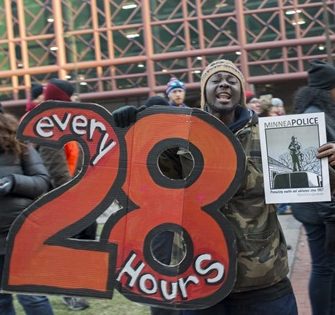An Introduction to ‘Black America:the street and the campus’ a special issue of Race & Class ( 35/1, July 1993)
Black America is in ferment. There is rebellion afoot. But, as yet, it is a rebellion waged in the cultural realm -over cultural issues such as identity and belonging and nationhood or, if over political issues such as racialised poverty and police brutality, still with cultural weapons such as music and film. The first is being wrought in the lush groves of academia, the second on the mean streets of the city. The first, though affording the black dispossessed a sense of worth and a pride of place, leads them finally into an inward-looking, reactionary nationalism, incapable of contesting the system that dispossesses them. The second, though expressing the raw anger of the street against oppression and exploitation, is in itself oppressive of women and exploitative of the young- a capitalist project, in effect, and of no real threat to the system either.
What compounds the problem, though, is that whereas in the ’60s, the rebellion on the street swept into the campus and politicised it, today those very successes have enabled the campus either to stand aloof from the street and romanticise it, or to ‘join’ the street and lead it back into a romanticised Africa. Where once, that is, there was an organic relationship between the street and the campus producing the organic intellectual, today the street cultures of resistance have been appropriated by academia and ‘disciplined’ into literary theory and cultural studies, and therein depoliticised. Or, they are being drained of their revolutionary energy by being drawn into cultural nationalist culs-de-sac.
This issue of Race & Class takes stock of the rebellion in Black America. In ‘Culture and rebellion’, Jan Carew recalls, with the immediacy of poetry, the excitement and promise of the black rebellions of the late 1960s when culture, as Cabral had said, was taking on political, economic and military forms to overthrow the oppressor. But it was the system that won out in the end – with black capitalism, on the one hand, and massive state repression, on the other. The first bought off the intelligentsia and the would-be governors and mayors, the second perverted the revolution and murdered the revolutionaries. Those who survived were thrown into prison, hopefully for ever. Two such men whom we have interviewed here are the Black Panthers Geronimo ji-jaga Pratt and Mumia Abu-Jamal, the one in maximum security and the other on death row. But prison has neither dimmed their political vision nor dulled their revolutionary fervour. Keeping them, and others like them, in prison for so long is, as Geronimo says, meant to remove all progressive leadership from the street and substitute instead the pimps and drug dealers and gangsters as role-models for the young. And that keeps the youth from the ‘basic principles of liberation and basic humanism for all people – for the Mexican people, the Indian people, for all the struggling peoples’. But then, the whole of America today is, as Abu-Jamal points out, fast becoming ‘the prison house of nations’.
How those nations broke their bonds in the ’70s and early ’80s and came together as artists and peoples and as artists for the people, ‘transforming their segregated society into a city-wide community’, is the story that Ivor Miller culls from the testimonies of the artists themselves in ‘Guerrilla artists of New York City’.
But today, black popular culture, while still vibrant with revolutionary potential, has, in its expression through film and music, become increasingly nationalist, money-oriented and sexist. ‘The macho boasting, misogyny, violent fantasies and false consciousness’, writes Clarence Lusane in ‘Rap, race and politics’, ‘exist side by side with an immature, but clear, critique o fauthority, a loathing of the oppressive character of wage labour, a hatred of racism and an expose of Reaganism.’
In their study of’Black popular culture’, Barbara Ransby and Tracye Matthews extend Lusane’s analysis on rap to Afrocentrism and the commodification of Malcolm X to show how the various forms of cultural nationalism, though carrying within them ‘an oppositional edge’, are redolent of ‘a very male-centred definition of the problems confronting the black community, and propose pseudo-solutions which further marginalise and denigrate black women’.
Ruth Gilmore ponders the role of black intellectuals in all this (in ‘Public enemies and private intellectuals’) and deplores their ongoing self-privatisation through ‘individual careerism’, ‘romantic particularism’ and ‘insider trading’ at a time when ‘apartheid, the political logic of late capitalism … privatises and individualises what should be collective and public, and explains away collective differences through group individualism’.
In the pursuit of such privatisation, argues Cedric Robinson, black scholars have, through the rigor and mortis of textual analysis, controverted Fanon’s diatribe against the national bourgeoisie and made him an ally in their own self-deceiving project. But this ‘Appropriation of Frantz Fanon’ is only one of the ways in which black academics interiorise the cultural insurgency around them. There is also the return to ‘traditional African ways’ that Afrocentricity advocates and which Sid Lemelle, in ‘The politics of cultural existence’, characterises as ‘ahistorical and idealistic’ – in contrast to Pan-Africanism which at least has ‘the potential to be a revolutionary “philosophy of praxis'”.
In a fitting conclusion to the volume, Manning Marable, in ‘Beyond racial identity politics’, argues that only a race/class synthesis can provide the basis on which all the oppressed communities of the US can equally unite. It is ‘our ability to transcend racial chauvinism, inter-ethnic hatred and old definitions of “race” [and] to recognise the class commonalities and joint social justice interests of all groups … [that can] break down the ancient walls of white violence, corporate power and class privilege’.

